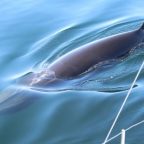
The Trump administration is considering rolling back federal protections for a number of national monuments. While most are on land and relatively accessible, three are deep below the ocean’s surface and many miles from the mainland: the Pacific Remote Islands Marine National Monument and the Rose Atoll Marine National Monument, both in the central Pacific Ocean, and the Northeast Canyons and Seamounts Marine National Monument off the coast of New England.
While most people will never explore the canyons and reefs of these watery realms, their value is hard to overestimate, according to Stanford scientists with years of experience exploring and studying these and adjacent areas.
The Stanford Woods Institute for the Environment spoke with marine experts Rob Dunbar, Fiorenza Micheli, Stephen Palumbi and Tim White about potential impacts from a loss of protections, including the resumption of commercial fishing in currently off-limits areas.
Why are protected ocean areas such as these so important?
Micheli: These are the only protected areas that are large enough to effectively protect highly mobile species, including sharks and seabirds. Within protected areas, fish and invertebrates can also attain large size. These large animals are ecologically important, but also support fisheries productivity and value through their high reproductive output and replenishment of fishing grounds, and their high value when they leave the protected areas and are caught.
Dunbar: These areas are home to large and very long-lived animals such as deep-sea corals and sponges. They provide habitat space for all kinds of smaller and mobile animals like fish and seem to be important nursery grounds for a number of key fish species. The shallow water areas are often important coral reef ecosystems that provide space and complexity that all other reef organisms depend on.
What short- and long-term impacts would the resumption of commercial fishing have on these areas?
Dunbar: If a trawl fisherman runs a net along the bottom, the destruction can be near total. Ecosystems may not return to a pre-disturbance state for many thousands of years. Fish recruitment declines, and the fisherman has killed the goose that lays golden eggs. It’s short-term gain and long-term disaster.
Palumbi: A major problem is the bycatch of species such as sharks, turtles and birds that fishermen do not want and cannot sell – sharks especially.
White: It’s not just fishing. If marine monuments are axed we could also see oil drilling and deep-sea mining happening just a 20-minute boat ride away from our nation’s healthiest coral reefs. This totally contradicts a bipartisan conservation legacy in the central Pacific: President George W. Bush created the Pacific Remote Islands Marine National Monument in 2009 and President Obama expanded this protection in 2014.
What do you make of the argument that the migratory nature of various fish means that monuments do little to actually protect them?
Dunbar: These monuments are effective breeding, reproduction and juvenile growth areas. By going farther afield from the monuments to catch fish, fishermen are more likely to still be able to catch fish in 10 or 20 years. The burden really needs to be on the fishing industry to prove convincingly that these areas can support more commercial activity without harming the resource.
Micheli: Several studies have documented a “fishing the line” response where fishing tends to redistribute and concentrate around the edges of protected areas. Increased reproductive output by large and more abundant animals within protected areas and migration of a fraction of individuals across their boundaries have been shown to compensate for shifts in fishing grounds. It is also important to remember that current protection amounts to less than 4 percent of the ocean, less than 2 percent protected from all extractive uses.
What, if anything, might be misunderstood or poorly understood in a federal analysis of whether to roll back protections in any or all of these areas?
Micheli: The expected economic gains of a protections rollback are poorly understood, likely overestimated and most likely unsustainable. The consequences for marine biodiversity and ocean resilience to climate variability and extremes are major and should be clearly accounted for in federal analysis.
Palumbi: Fishing is not a precisely targeted business that lets you take only what you are authorized to take. Fishermen catch a range of other species besides what they are licensed for, like sharks that play important roles in ocean ecosystems. It’s like foresters on national lands being allowed to cut down a few large redwoods, but bulldozing dozens of other trees to get them. A second issue is who crews these boats – there have been reports of low-paid foreign workers virtually imprisoned on boats, unable to leave the boat at port because they lack documentation.
Dunbar: What’s happening now has the appearance of rollback by fiat – without taking into consideration years, if not decades, of sound science. There is a reason these areas were protected and those reasons were based on careful and thoughtful analysis of the available data and the proposals evolved over a long period of time.
Rob Dunbar is the W.M. Keck Professor in the School of Earth, Energy & Environmental Sciences, a senior fellow at the Stanford Woods Institute for the Environment and a member of Stanford Bio-X.
Fiorenza Micheli is the David and Lucile Packard Professor of Marine Science at Stanford’s Hopkins Marine Station, a senior fellow at the Stanford Woods Institute for the Environment and co-director of Stanford’s Center for Ocean Solutions.
Stephen Palumbi is the Jane and Marshall Steel Jr. Professor in Marine Sciences at Stanford’s Hopkins Marine Station and a senior fellow at the Stanford Woods Institute for the Environment.
Tim White is a doctoral student in biology.















Social Profiles